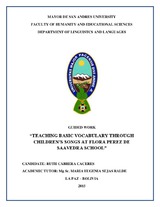Teaching basic vocabulary through Children’s songs at flora Perez de Saavedra school
Fecha
2015Autor
Cabrera Cáceres, Ruth
Sejas Ralde, María Eugenia (Tutor)
Metadatos
Mostrar el registro completo del ítemResumen
This project implemented the songs as an option to teach a foreign language. The project takes the Total Physical Response (TPR) and Active method in order to promote students English learning process. Working with Total Physical Respond method, we provide instruction exclusively in the target language foster the brain body connection and engage students in developmentally appropriate activities. According to the results, we perceived that the children are good learners of another language, because they appreciated their retention of the vocabulary and enjoyed the language learning process. As we mention in chapter IV the use of children songs in the process of teaching and learning was so successful. The songs are so useful and can be adapted easily to teach other subject. In order to this, the objectives of this project was successfully achieved.This project begins with a Diagnostic section which describes and provides information about the context in which the project was developed, the population that we have worked, the general and specific objectives, the analysis of the results about children’s needs with regard to learning English language and the reason to develop this project. This work contains the Theoretical basis supports, reviews of representative literature related with songs in the teaching English, also about Total Physical Response method and Active method focus in oral communication and corporal actions. After the Theoretical basis is the Proposal section which presents a course program for this project includes objectives, methodology and procedures, also provides the Syllabus Design for every English Course program, for pre-school children. This research work has general conclusion and an appendix that contain samples of ten syllabuses Design of English course everyone is supported by a song. Finally we have the conclusions and the recommendations section

